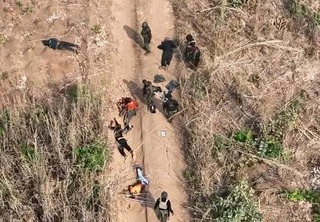Fall of Diapaga: Togo faces new security threat as Jihadists seize strategic town in Burkina Faso
The recent fall of Diapaga, a strategic town in eastern Burkina Faso, into the hands of jihadist fighters of the Jama’at Nusrat al-Islam wal-Muslimin (JNIM), has triggered serious uncertainty across the West African sub-region, particularly for neighbouring Togo.
The development, described by regional security analysts as a watershed moment in the Sahelian insurgency, spotlighted a growing danger to coastal states. With Diapaga located less than 25 kilometres from the Togolese border, the implications of its fall extend well beyond Burkina Faso.
Until recently, Diapaga served as a vital security buffer a final outpost held by Burkinabe forces to prevent incursions into northern Togo. Its capture by jihadists marks not only a military setback for the transitional authorities in Ouagadougou but also signals a profound geopolitical shift.
JNIM’s seizure of the town brings the terrorist group to the very gates of Togo. The loss of Diapaga has enabled the insurgents to consolidate a new base of operations, reinforcing their arsenal with weapons, vehicles, and other combat logistics captured from Burkinabe forces.
Security experts warn that this victory gives JNIM an unprecedented territorial foothold and operational capacity, placing key Togolese localities such as Tambi, Koundjoaré, Mango, and even Dapaong at increased risk of infiltration or attack.
“This is a tipping point,” said a regional defence analyst who spoke under anonymity. “It’s no longer about containing jihadists in the Sahel. They are now knocking on the doors of the Gulf of Guinea.”
Beyond its military relevance, Diapaga’s fall threatens a crucial commercial artery: the Lomé–Fada N’Gourma–Ouagadougou axis. This corridor facilitates the movement of goods from the Port of Lomé into the Sahel, serving as a vital logistics and revenue channel for Togo and the landlocked countries of Burkina Faso, Mali, and Niger.
Amid tensions between Niger and Benin, the government in Niamey has shut its border with Benin and declined to use Cotonou’s port, making the Lomé corridor the preferred alternative. The new threat, therefore, places Togo’s economic lifeline in jeopardy.
With increased jihadist activity near its frontier, the possibility of targeted disruptions, ambushes, or sabotage along this route grows stronger.
Rethinking Security Alliances
For years, Togo pursued a policy of regional cooperation, working closely with Burkina Faso’s military to secure shared borders. However, analysts say the deterioration of Burkina Faso’s capacity to hold territory under the leadership of Captain Ibrahim Traoré has exposed Togo to vulnerabilities beyond its current defence posture.
“There is growing concern that the Burkinabe military, overwhelmed and fragmented, has become the weak link in the security chain,” said a retired Togolese officer. “It’s time for Togo to reassess its partnerships and take autonomous steps to protect its sovereignty.”
Observers are now calling on the Togolese government to declare a state of heightened alert along its northeastern corridor. This would involve the deployment of surveillance drones, fortified border outposts, intelligence-sharing mechanisms, and reinforced rapid response teams.
Community engagement and deradicalization efforts are also being advocated, particularly in vulnerable areas such as Kara and Sokodé, which could become future targets.
The expansion of jihadist operations from the Sahel into coastal West Africa is no longer a hypothetical threat it is an unfolding reality. The collapse of Diapaga should serve as a wake-up call, not just for Togo but for the entire Gulf of Guinea region.
The dynamics of the insurgency are shifting, and if left unchecked, the fragile security and economic balance of the region could tilt into chaos.










